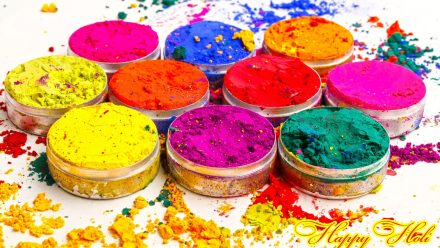Most of us are familiar with the origin story of Prahlad that is associated with the colourful festival of Phagwa or Holi. In Sanaatan Dharma, there are sometimes multiple origin stories for our festivals. As human beings, we are all built for narrative or story so they are a very effective way of passing down traditions. However, these stories usually contain a deeper spiritual message.
One of the origin stories of Phagwa revolves around Shree Krishna. Shree Krishna’s mother gave him various coloured powders and said he should take them to Radha and colour her with them. He did so and their relationship was built upon this experience and it was celebrated as Phagwa.
At a deeper level, if we refer to the ancient Vedic science which deals with etymology, the study concerned with the correct interpretation of words in Sanskrit, we can uncover a deeper meaning to this origin story. Krish means ‘attraction’ and na means ‘ananda’ or ‘Supreme Bliss’. Krishna, therefore, means ‘that Supreme Bliss that attracts us’. Krish also means ‘existence’ and na means ‘to stop’. Together, they mean ‘that which stops this cycle of birth and death’. Radha means ‘fortunate’ or ‘successful’. The root of the word is aradha or aradhana, which means ‘worship’ or ‘devotion’. At a metaphysical level, it is said that Shree Krishna has the Lord’s maya potency and the Lord’s chit potency, and the protector of these powers of the Lord is Radha. So Krishna and Radha always go together, as purush and prakriti. Radha is also a form of Sri or Lakshmi, and so is Rukmini. Radha, devotion, is transformed into Rukmini, which means ‘to shine’ or ‘to please’ and also represents the shat sampath or six forms of wealth.
It is said in the Skanda Puraana that there is a real, physical Vrindavan and a spiritual Vrindavan, where Shree Radha and Krishna play Phagwa. The only difference between both is that the killing of the demons is absent. This means that Phagwa can only take place within us if we eliminate the negative qualities represented by demons. When the coverings of maya are removed, we can experience the spiritual, Supreme Bliss. In the play or leela of the Divine, in terms of the functions of the Divine, there is the enfolding and concealing as well as the unfolding or revealing nature of the Divine. The Supreme Lord is playing hide and seek with Himself. So Krishna and Radha colour each other with the powders so that they can’t distinguish one from the other and then they remove that covering so that their true selves are shown. It’s a play of the Lord with Himself, through His shakti or energy.
The symbolism of the colouring is important. Each of us have a unique colour, and each has his or her own place in the universe. We all belong to this creation and each colour is seen and enjoyed for its own worth. The Supreme Self observes His own Self in a variety of forms and colours in His leela and then dissolves once again. Also, on another level, we need to empty ourselves in order to become coloured by the Supreme Being.
As a starting point, we need to surrender the attachment to our limited selves, to thinking that I am only this body, mind and nothing more. This is the root of all problems. Colour perception is an individual understanding. Each person sees colour differently as colour consists of different wavelengths. Colour is created in the body and mind. Some people experience colour blindness. We learn from colour perception that this world is unreal. It is a creation of our own minds. Instead of being coloured by the world, we should look for the internal colouring of the Self.
Phagwa is a celebration of the play of the Lord in covering and revealing His true essence. It also encourages us to colour ourselves in the right way, not in terms of the external, physical colour, but the internal colours of the Lord. The external celebration of Phagwa is only meaningful when we have this realisation.
Pt. Dr. Umesh Persad, Spiritual Leader, Gyaan Deepak Kirtan Mandali (from a Sunday morning service)



